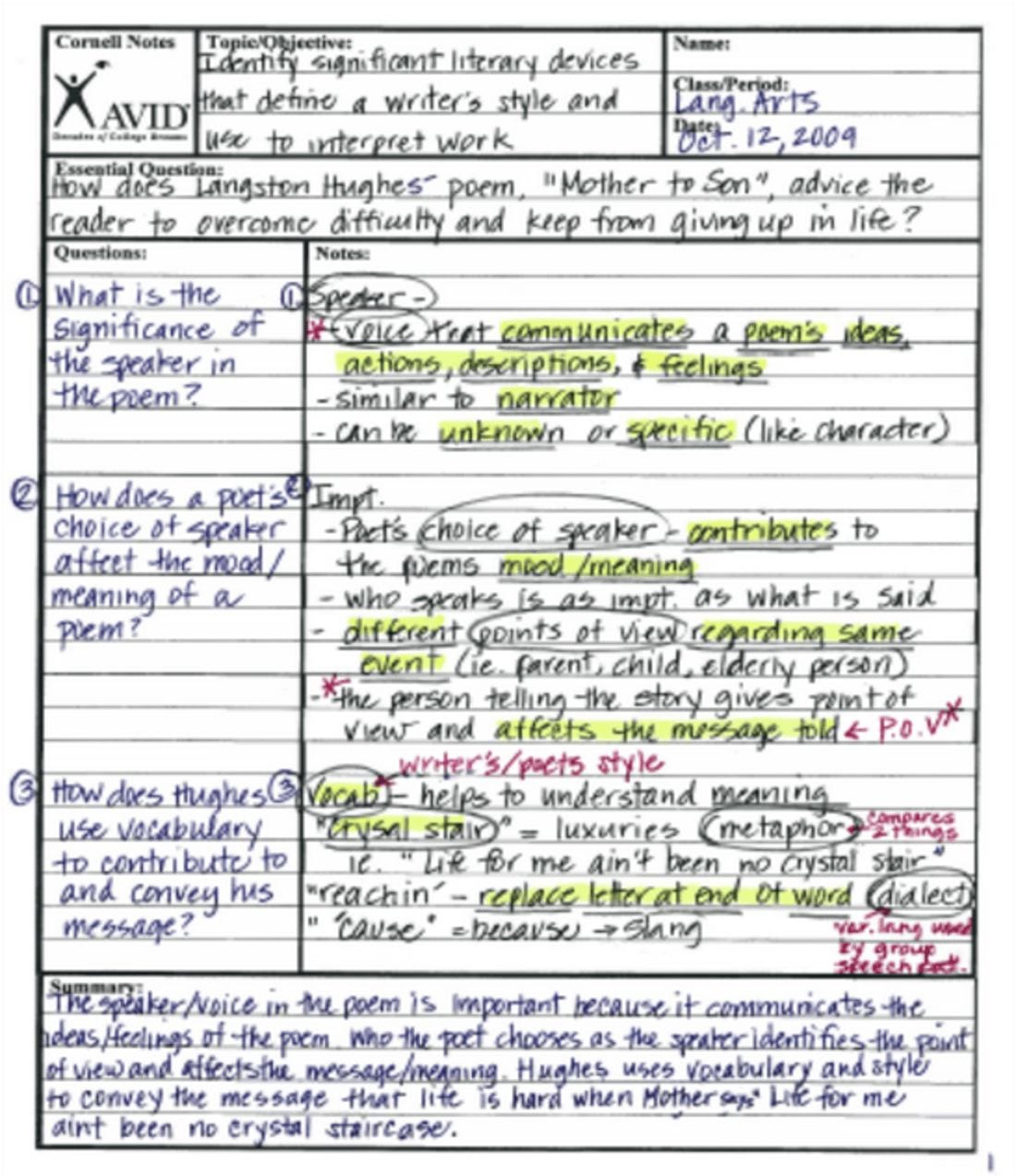What do your notes look like?
Think back to the last time you took notes. Perhaps you were in a PL session or meeting, studying for your masters, or preparing for a class?
What kind of note taker are you? Are your notes full of doodles, a series of unconnected key words that make no sense to you when you go back to them? or are they a source of personal pride, with colour coded key words and diagrams? Would your notes make sense to someone else? And should it matter if they don’t?
Were you ever taught explicitly how to take notes or has your approach simply evolved over time?
Why take notes?
Like collaboration, essay writing, problem solving and presentation skills, note taking sits under the banner of core learning life skills that we hope all our students will develop while they are with us. But why is this? What is the value of note taking in the learning process?
To many students this question might seem obvious:
“I take notes to record ideas so I don’t forget them.”
The implication of this is that note taking is about writing down everything you are told in class. We have probably all seen students attempting to copy information from presentations as quickly as they can, not sure what is relevant and so writing it all down just in case.
And if note taking really is just about recording external information many students might legitimately ask, why can’t we just be given a handout to save us the bother?
But teachers know that effective note taking is not just about recording information that has been learned (or so it can be ‘learned’ later for exams). Effective note taking is about actively engaging with ideas rather than passively receiving them. It is a way that we learn not just a record of what we have learned.
So effective note taking helps learning by supporting students:
- record new ideas in their working memory so that these ideas can be processed and they can be later transferred to their long term memory
- connect new ideas to existing knowledge
- make their thinking visible so that it can be more easily processed and shared with others
- organise ideas so that patterns can more easily be seen
- make meaning from information by building conceptual understandings
In short, effective note taking is a powerful skill. And it is a skill that can be taught.
So what does effective note taking look like?
And when and how should we teach these skills to students?
PD Dessert is an open invitation group (an offshoot of Books and Burritos that is also led by Kurt) that meets once a month in the staffroom on a Friday afternoon for conversations on pedagogical topics. Our first meeting was about note taking. 15 teachers from middle and high school met to share what note taking looks like in their contexts and to discuss the research around good practice when it comes to note taking.
The stimulus for this meeting was this thought provoking blog post on note taking.
The conversation was lively and stimulating, the territory ranging from the merits of writing frames (such as Cornell notes) and graphic organisers (such as Venn diagrams) to the perennial debate over hand written notes vs use of laptops or tablets. Teachers shared their experiences of Sketch-noting and apps such as Evernote or Rocketbook. Middle school teachers explained how note taking is explicitly taught in their context; and we also discussed the role that note taking plays in different high school classes and the challenge we all face in getting students to transfer skills between contexts.
What emerged from our conversation was a tentative set of criteria that might inform how we support the acquisition and development of note taking skills. This criteria can be seen below
Note taking is most effective when
- It has been explicitly taught as a skill
- Students have an opportunity to practice a variety of strategies
- Students understand the affordances of a particular strategy (what that particular approach enables you to do)
- Students have the freedom to choose the approach that works for them and is appropriate for the task at hand
- Information is not simply recorded, but is processed in some way as the notes are made eg. connections between ideas are shown; questions are recorded; key concepts are identified; generalisations are made.
- Notes are reviewed, so that key ideas can be synthesised (Cornell notes has this built in with the summary at the foot of the frame)
What might this look like in our classrooms?
We already know how students learn (learning principles). Here are some specific strategies to support note taking skills, paired with the relevant learning principle. We might map these approaches on this document.
| Learning Principle | Strategies to try |
| learners construct new understanding by activating prior knowledge and experiences | encourage students to transfer note taking skills from academic classes to new situations eg. within service leadership or mentor/advisory group
begin lesson with students reviewing notes to draw out key ideas learned in the previous lesson |
| learners use timely and goal directed feedback | have check-ins for peer feedback;
as an alternative to marking homework occasionally collect in notes and provide feedback Compare different sets of student notes on a shared presentation to draw out similarities and differences and identify targets |
| learners collaborate | Co-create a rubric around what good notes look like for that class
Use shared note-taking software eg. TodaysMeet to expose students to how others take notes |
| learners are challenged | add to their toolbox of note taking strategies with more sophisticated tools as they get older |
| learners feel secure and supported | Explicitly teach students how they might organize their notes for your class (do not assume they already know how to do it) |
| learners construct meaning by seeing patterns and making connections | model for students how to connect ideas in their notes, explore patterns in ideas, identify core concepts, and draw out generalisations |
| learners actively process and reflect | provide time in class or homework for students to acquire and practice note taking skills, and then review notes later |
| learners apply metacognitive skills | ask students to reflect on their note taking skills and set goals for improvement |
| learners understand the purpose of the learning | remind students of the value of note taking as a life learning skill and model how you use note taking in your own learning |
| learners have ownership of their learning | give students choice over which note taking strategies they wish to use |
What is the best way to take notes?
This hotly debated topic has arguments on both sides. This article summarises some of the benefits of handwriting for building conceptual understanding but there are staunch advocates for the benefits of typing notes. The simple answer is that both approaches have their merits.
Merits of hand writing
Physical scripting of words & tangible value kinaesthetic aspects has cognitive value
Ability to draw
Practice for exams which will eventually be hand written
No lap-top barrier in class – engagement & human connection
Messy/crossings out remind students that mistakes are ok & help students to be in the moment
Reinforce the need to develop organisational skills as students need to curate and collate notes in some way (eg. Folders)
Merits of laptop/device
Redrafting later is easier
Mixed media can be incorporated eg. through inserted images, hyperlinks
Easier to share and opportunities for wider collaboration (eg. through google docs)
Notes less likely to be lost as can be stored in the cloud
Reinforce the need to develop organisational skills as students need to curate and collate notes in some way (eg. Google folders)
Devices such as tablets can be used to combine the benefits of both




